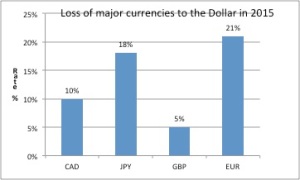Molecular Systems Biology http://msb.embopress.org/authorguide “levies an Article Processing Charge (APC) of 2,950 EUROS (3,900 USD/GBP 2,500) for each Research Articles or Reports accepted for publication. There are no additional costs (such as page charges or submission charges).” The 2,950 EUROS is a 2% price decrease from the 3,000 EUROS we noted last year. But is it really a price decrease? Correction May 22: I got the currency difference backwards – a 21% loss in the EUR should mean a 21% price increase in the EUR, not decrease. The basic concept that it is not possible to understand whether prices are flat, decreasing or increasing without having information on the pricing in all the currencies remains. Original wording: As we recently calculated, the EURO has lost 21% in comparison with the USD over the past year. If the USD is the primary currency (likely the reason for the current EUR price decrease), then the equivalent in EUR today would be 2,370 EUR. What looks like a 50 EUR or 2% price decrease may actually be a 580 EUR or 24% increase. Last year we did not capture pricing in all the currencies so cannot confirm.
The International Journal of Engineering Innovations and Research is one of many journals and publishers offering pricing in more than one currency. In this case, only Indian authors have the option of paying in INR. The price in USD has decreased slightly from 2014, from 125 to 120, likely reflecting the stronger US currency. We did not capture the price in INR in 2014 for comparison purposes. From http://www.ijeir.org/index.php/authors/article-prossecing-fee
For foreign
- 120 USD for publishing.
- Paper should not be greater than 10 pages.
- For each extra page, 5 USD will be charged.
Indian author will be charge
- Rs. 4000/- upto 10 pages of paper.
For each extra page, Rs. 250/- will be charged.
Science Domain International has an interesting approach, at least for now: the pricing after a special time-limited discount is applied (April to end of May 2015) of 80 – 95% for each journal is presented as the effective price in US, EUR, INR, GBP and CNY. It is clear that the base price is $500 USD with the other prices included as explanation.
This is just one example; there are many publishers offering pricing in different currencies, often combined with differential pricing based on where the author is from.
This post is part of the open access article processing charges project.
Cite as:
Morrison, H. (2015). Pricing in more than one currency and pricing for local authors. Sustaining the Knowledge Commons / Soutenir Les Savoirs Communs. Retrieved from https://sustainingknowledgecommons.org/2015/05/21/pricing-in-more-than-one-currency-and-pricing-for-local-authors/


